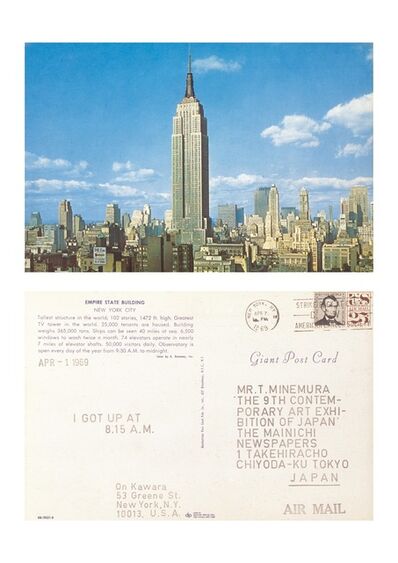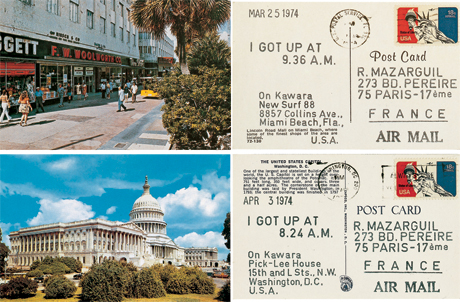https://www.davidzwirner.com/artists/on-kawara/biography
'For over five decades, On Kawara (29,771 days) created paintings, drawings, books, and recordings that examined chronological time and its function as a measure of human existence. The artist began making his now signature “date paintings” on January 4, 1966 in New York City and continued to make them in different parts of the world until 2013.'http://www.artnet.com/artists/on-kawara/
'On Kawara was an influential Japanese Conceptual artist. Best known for his Today series of paintings, Kawara produced simple, two-color acrylic paintings to document each day he woke up alive in the date, language, and format of the place in which they were made. He made almost 3,000 of these paintings in 112 different cities between January 4, 1966 and his death in 2014, with the body of work serving as an examination of the banality of existence and the passage of time. Born on December 24, 1932 in Kariya, Japan, he went on to study art and travel in Mexico where his father was the director of an engineering company. Much of Kawara’s later life was spent traveling between New York and Paris, marking the differences of life around the world through his serial artworks.'
I AM STILL ALIVE, 1996, telegram and envelope, 15.1 x 21 cm
I AM STILL ALIVE, 1973, 14.9 x 21 cm
I love the simple but very raw statement of I AM STILL ALIVE, and Kawara is definitely someone to look at when thinking about time and temporality.. I'm always thinking about time... it's very human..
------------------------------
Contrasted with the random temporal shifts conveyed in the text messages are the diverse images of Manhattan featured on the postcard fronts, which accumulate over the piece's forty-seven day duration into an unexpectedly quasi-cinematic aerial tour of the city-circling around the United Nations (and inside the General Assembly), down the East River along the waterfront to New York Harbor and the Statue of Liberty, and finally roaming around Federal Plaza at street level before coming to rest at City Hall. Like the newspaper pages that line the special cases housing each date painting, these found images juxtapose the infinite variety and quotidian reality of the public world with the elliptical, self-reflexive messages on the back. The sequence also extracts a drifting urban poetry from the mass-produced and anonymous, layering it conceptually over the banal, functional postal route of the objects themselves, as well as reintroducing a formal design to a work that is at first glance anticompositional.
With tremendous economy of means and a surprising visual elegance, Kawara creates a complex meditation on time, existence, and the relationship between art and life.'
(could postcard images be considered 'abandoned places?' and in that sense, all photographs as soon as they are taken? you take a picture, you leave the place..) (side note these images of japan feel very nostalgic... maybe I should dig through and see what images I have of the place a few years back)
I think the postcard/ souvenir idea will always stick with me... maybe I should continue that work again.. I really love the text vs. image (which could be photograph or drawing etc.) vs. the 'memory'/travel/ sending it to someone idea.. (would it be a physical print / poster size etc...)




















